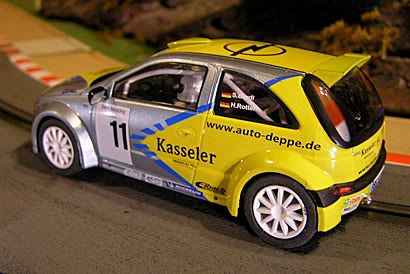
The entry level rally car in Europe is the S1600 class which consists of small, FWD hatchbacks made by most manufacturers and seen commonly on roads all over Europe. This is the stepping stone rally class to the faster S2000 class and eventually the mighty AWD turbo cars of the WRC, the World Rally Championship. The smaller cars of the S1600 rally class are already well covered by other slot car manufacturers, with the Citroën Saxo, Fiat Punto, Ford Festiva, VW Polo, and SEAT Ibiza all available. Sloter enters the class with the Opel Corsa 1600.
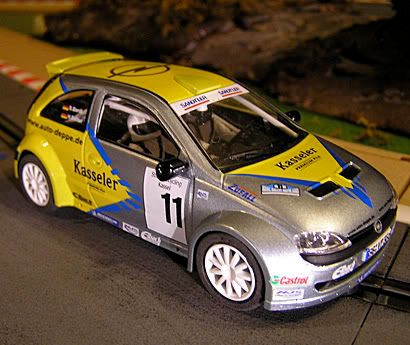
The Sloter Opel Corsa is an aggressive looking, but small car with a spoiler at the rear and an air scoop at the front of the roof panel. It is covered in a factory rally livery of silver, blue, and yellow with a large Opel logo on the roof. The paint and striping quality is pretty good, but the yellow on the scoop and spoiler is a little thin and there are places where the stripes are not as crisp as they could be. There is a fairly well detailed, full depth interior with a full roll cage and driver and navigator figures. The Corsa is also available in a “roll out” livery, as well as a plain white version if you’d like to do your own livery.
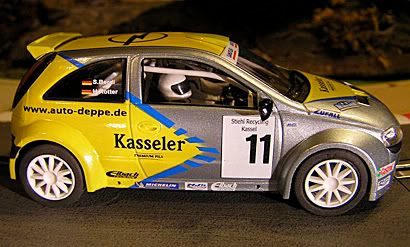
The reason the Opel has a full depth interior is it’s a sidewinder (SW) drive train, which I believe is a first in it’s class and unusual in slot rally cars in general. It also has a very unique and innovative motor pod design. The pod looks a bit like a Slot it type at first because it has four screws near the corners, but it is not designed to float. Instead, it is made to be modular, allowing different types of motors to be mounted in different orientations using the same pod! They do this by using some very clever inserts which simply snap into the main pod. The inserts are then locked in place when the pod slides into the chassis. The pod actually slides up into the chassis about ¼” into a very tight fitting cavity, eliminating any possible movement or flex required to remove the inserts.
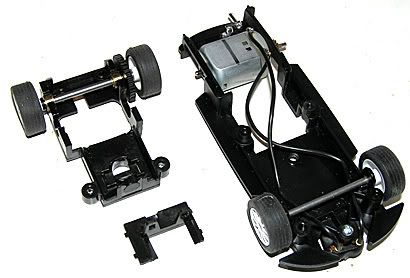
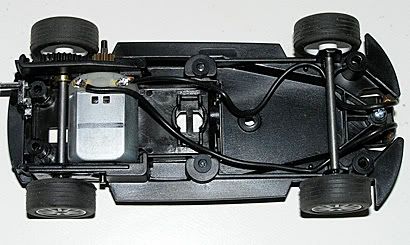
The motor is a standard Mabuchi (18k) similar to other RTRs mounted in a bell drive SW configuration, but the pod also allows a long can boxer style motor to be mounted in an inline configuration. This is done by removing the front insert in the pod, after removing the pod assembly from the chassis. The rear pod screws also function as the rear body mount screws, so after removing the body with two screws in front and the two rear pod screws, all that is required to remove the pod from the chassis is to remove the front two pod screws. The pod then slides down out of the chassis and the front insert, which contains a thick Fly/Ninco sized button magnet, can be snapped out. After the motor is removed, the extra pod insert that comes with the car can be snapped in place of the SW motor and you have converted the pod to a long can inline set up. Of coarse you will have to change out the SW spur gear for an inline crown gear (not included), but a very clever design!
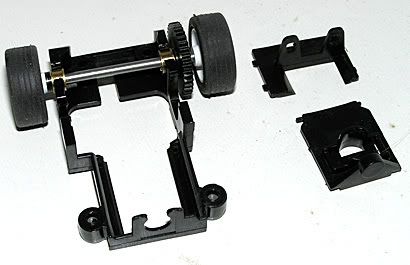
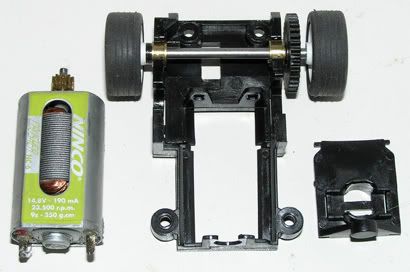
I ran the car straight out of the box, with the magnet, and it went very well. Not too stuck down, but very stable. It read about 180gms on the Magnet Marshall total, with a weight of about 79gms, so about 100 grams of additional down force. The car did have quite a bit of gear noise from what turned out to be a slightly tight gear mesh. It has quieted with additional running and I would prefer a little tight out of the box, as opposed to too loose to begin with. It was now time to remove the magnet, as I believe all rally cars should be set up, so I lubed the bushings while I had the body off. This is where I ran into problems. The tires are rather soft and although there was no problem running with the magnet, the tire spin when the magnet was removed caused the tires to expand and come off the wheels. I had a similar issue with the Sloter Opel, so I got some glue to fix the tires to the wheels.
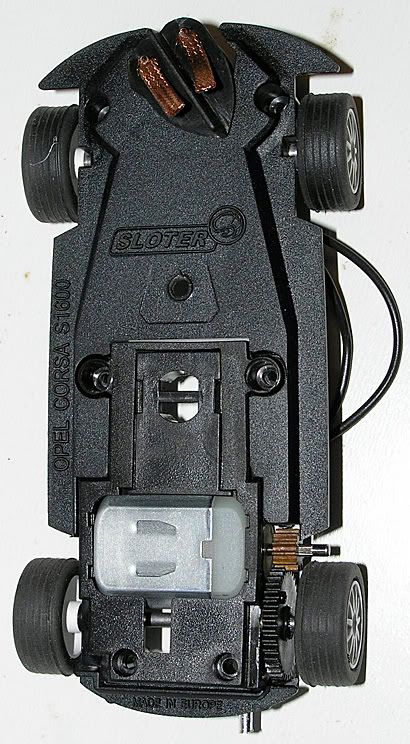
Unfortunately, a bumbled and hurried attempt at using fast Superglue resulted in destroying the stock tires. Slower glue gives time to seat the tires correctly, for future reference! Normally this would not be a problem, but the Corsa uses a strange size tire, about 20mm x 8mm?! Even in my large collection of spares, I had nothing similar. Fortunately, the wheels were a standard size and some Ninco ribbed rally tires in 19x10 size fit just fine. A little Dremel work in the rear wheel wells was required to give clearance for the wider tires, but just a bit. The stock tires are pretty soft and I think they would work fine for non-mag running if glued to the rims, but be careful and use a slower adhesive, unlike myself.
With new tires installed, we were ready to do some real rally drifting! And drifting is what this Opel excels at! I was amazed as I got up to speed by the degree of control afforded by this very small car. The more I drove it, the more I liked it. Most of the smaller slot cars tend to be rather tricky to control at the limit because of the short wheelbase and narrow track, but the Corsa was very easy to drift in a nice controlled arc, all the way through most turns. The standard 18k Mabuchi motor is plenty powerful for this small car, but an NC-2 might also work well in the long can, inline configuration. I just can not imagine the car being any better balanced than it is now. Sloter still could work on making the wheels more concentric, as the car vibrates a bit, but overall this car is an improvement over their first rally car, the Opel Manta, and probably the fastest S1600 class slot rally car available at this time.

The Sloter Opel Corsa is an aggressive looking, but small car with a spoiler at the rear and an air scoop at the front of the roof panel. It is covered in a factory rally livery of silver, blue, and yellow with a large Opel logo on the roof. The paint and striping quality is pretty good, but the yellow on the scoop and spoiler is a little thin and there are places where the stripes are not as crisp as they could be. There is a fairly well detailed, full depth interior with a full roll cage and driver and navigator figures. The Corsa is also available in a “roll out” livery, as well as a plain white version if you’d like to do your own livery.

The reason the Opel has a full depth interior is it’s a sidewinder (SW) drive train, which I believe is a first in it’s class and unusual in slot rally cars in general. It also has a very unique and innovative motor pod design. The pod looks a bit like a Slot it type at first because it has four screws near the corners, but it is not designed to float. Instead, it is made to be modular, allowing different types of motors to be mounted in different orientations using the same pod! They do this by using some very clever inserts which simply snap into the main pod. The inserts are then locked in place when the pod slides into the chassis. The pod actually slides up into the chassis about ¼” into a very tight fitting cavity, eliminating any possible movement or flex required to remove the inserts.


The motor is a standard Mabuchi (18k) similar to other RTRs mounted in a bell drive SW configuration, but the pod also allows a long can boxer style motor to be mounted in an inline configuration. This is done by removing the front insert in the pod, after removing the pod assembly from the chassis. The rear pod screws also function as the rear body mount screws, so after removing the body with two screws in front and the two rear pod screws, all that is required to remove the pod from the chassis is to remove the front two pod screws. The pod then slides down out of the chassis and the front insert, which contains a thick Fly/Ninco sized button magnet, can be snapped out. After the motor is removed, the extra pod insert that comes with the car can be snapped in place of the SW motor and you have converted the pod to a long can inline set up. Of coarse you will have to change out the SW spur gear for an inline crown gear (not included), but a very clever design!


I ran the car straight out of the box, with the magnet, and it went very well. Not too stuck down, but very stable. It read about 180gms on the Magnet Marshall total, with a weight of about 79gms, so about 100 grams of additional down force. The car did have quite a bit of gear noise from what turned out to be a slightly tight gear mesh. It has quieted with additional running and I would prefer a little tight out of the box, as opposed to too loose to begin with. It was now time to remove the magnet, as I believe all rally cars should be set up, so I lubed the bushings while I had the body off. This is where I ran into problems. The tires are rather soft and although there was no problem running with the magnet, the tire spin when the magnet was removed caused the tires to expand and come off the wheels. I had a similar issue with the Sloter Opel, so I got some glue to fix the tires to the wheels.

Unfortunately, a bumbled and hurried attempt at using fast Superglue resulted in destroying the stock tires. Slower glue gives time to seat the tires correctly, for future reference! Normally this would not be a problem, but the Corsa uses a strange size tire, about 20mm x 8mm?! Even in my large collection of spares, I had nothing similar. Fortunately, the wheels were a standard size and some Ninco ribbed rally tires in 19x10 size fit just fine. A little Dremel work in the rear wheel wells was required to give clearance for the wider tires, but just a bit. The stock tires are pretty soft and I think they would work fine for non-mag running if glued to the rims, but be careful and use a slower adhesive, unlike myself.
With new tires installed, we were ready to do some real rally drifting! And drifting is what this Opel excels at! I was amazed as I got up to speed by the degree of control afforded by this very small car. The more I drove it, the more I liked it. Most of the smaller slot cars tend to be rather tricky to control at the limit because of the short wheelbase and narrow track, but the Corsa was very easy to drift in a nice controlled arc, all the way through most turns. The standard 18k Mabuchi motor is plenty powerful for this small car, but an NC-2 might also work well in the long can, inline configuration. I just can not imagine the car being any better balanced than it is now. Sloter still could work on making the wheels more concentric, as the car vibrates a bit, but overall this car is an improvement over their first rally car, the Opel Manta, and probably the fastest S1600 class slot rally car available at this time.
No comments:
Post a Comment
Note: Only a member of this blog may post a comment.